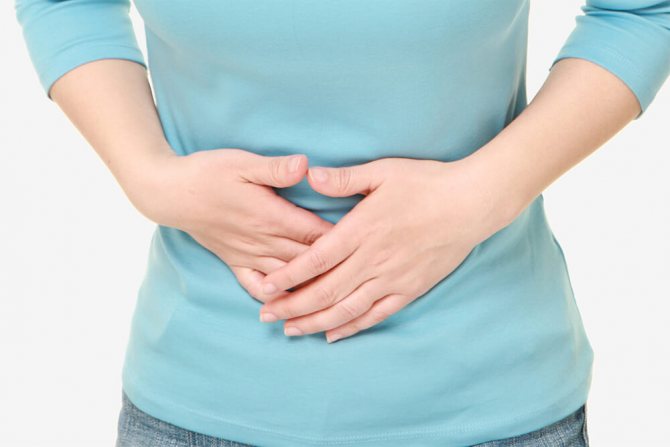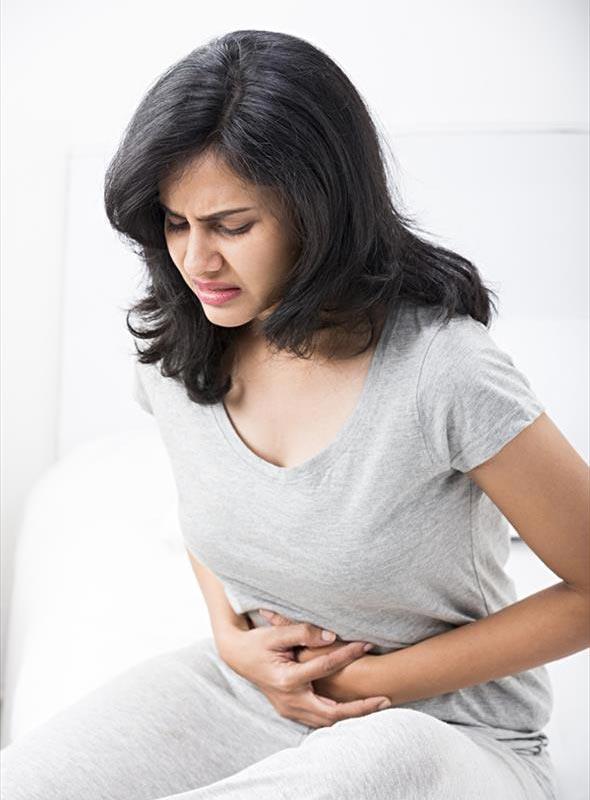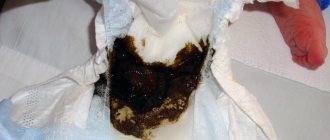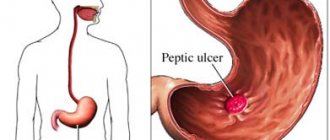What should normal stool look like?
Based on the state of the stool, you can determine how the digestive system works and whether all systems of the body as a whole are functioning correctly. It is no coincidence that the analysis of intestinal discharge is required upon admission of the patient to the hospital. Feces is the mass that is excreted from the body after food is digested. Black feces in an adult can only be normal when certain foods are consumed (described below). If dark color of feces is observed against the background of normal nutrition, you need to make an appointment with a doctor.
The type of stool depends on the patient's eating habits, as well as the length of time the feces remain in the rectum. Healthy people should produce dense feces with a moderately soft consistency. The color should be brown. In this case, the shade will depend on the products that the patient consumed the day before.
Why does stool turn black?
A change in the color of fecal matter due to the intake of activated carbon is not considered a pathological deviation.
This manifestation has its own explanation - the drug is not absorbed into the organs of the digestive system and does not penetrate into the blood, like other medications. Exit from the intestines occurs naturally, as part of fecal matter. This is the simple reason for identifying black inclusions in biological material.
It is important to remember that there are many other reasons that contribute to changes in the color of stool, examples of which include excess iron content, ulcerative lesions of the stomach or intestinal tract, trauma, and neoplasms. In each case, it is recommended to monitor the shade of the stool to be sure that the cause of the blackness is associated precisely with the activated carbon tablets.
When fecal matter is charcoal-colored and emits a foul odor, this phenomenon is called black disease or melena. The causes may be serious pathologies accompanied by bleeding in the upper organs of the gastrointestinal tract.
The main symptoms are accompanied by other signs - dark vomiting, feelings of nausea, pain and bleeding.
Melena is diagnosed when:
- hernia;
- the presence of benign tumors;
- polyps;
- ulcer;
- foreign bodies in the stomach.
The onset of bleeding is preceded by vomiting, and strong feces appear about ten hours later. With constipation, stool is observed after a day.
The black color appears due to irritation of the mucous membrane of the digestive system that appears during poisoning.
Pregnant women are characterized by iron deficiency. Women are prescribed multivitamins containing this component. Black feces represent iron residues excreted from the body.
Dark-colored fecal matter in a child should alert parents. If the baby behaves naturally, worries are unnecessary. Black stool can be caused by eating too much chocolate. But if your health worsens, it is recommended to visit a doctor.
On the third day of life, the baby experiences black feces - meconium, which contains remnants of epithelium, water, mucus and bile. After some time, the feces will acquire a normal color. In addition, the cause of darkening of the biological mass is certain fruits and berries, which should not be excluded from the daily diet.

Feces in newborns
Young mothers may be alarmed by their baby's black stool in the first hours after birth. A qualified doctor must prepare the woman in advance. Black stool in newborn babies is meconium. The baby's first bowel movements contain amniotic fluid, which the baby absorbed while still in the womb. Meconium has a viscous, sticky consistency and can stick to your baby's skin. In this case, feces are easily washed off with plain warm water. It is recommended to use boiled water to wash the newborn in the first days.

Original feces are usually passed for no more than two days. Then the baby's stool acquires a softer consistency and becomes light yellow or greenish. If black feces are observed in your baby for more than three days, you should definitely inform your doctor about it.
What foods make stool black?
In the body of any person throughout life, biochemical reactions occur aimed at converting food into energy. Some substances are converted into others. So, after eating delicious dishes, feces enter the intestines, the color of which directly depends on the composition of the food.
In a healthy state, black feces may well appear in an adult. The reasons for this will be the use of coloring products. The color of feces almost always changes when consuming foods containing animal blood. These are blood sausage, liver, and some types of meat. Black stool can also be observed with excessive consumption of coffee or strong tea. The following plant products can also stain feces: red beets, tomatoes, grapes, blueberries, pomegranates, prunes, chokeberries.

If the feces turn black and the person feels great, there is no reason to panic. All you need to do is observe the condition of your stool after changing your diet. If the color is restored, it means the digestive system is functioning correctly. But the presence of black feces for several days is a reason to seek help.
Black stool after activated charcoal – Doctor’s Help
The removal of fecal matter from the body by the intestinal tract is a normal physiological phenomenon. As a rule, the shade of biological material varies from light to dark brown tones. Sometimes it happens that the stool comes out black. The reasons for this are different, but after activated carbon, black stools definitely happen.
What you need to know about activated carbon?
This generic belongs to the adsorbent group of medications.
Most people feel scared when, after taking activated carbon, they observe the release of black feces, not realizing that this is a completely normal phenomenon.
The basis of the tablets is a component of natural origin – activated carbon. It is a material with a porous structure, has a characteristic black tint, and the surface is rough.
Coal is used in the chemical field, cosmetology and the medical industry. With the help of tablets, a person gets rid of the discomfort of food poisoning or severe overeating.
The main element is so active that it absorbs dangerous components and helps to remove them in the usual way.
The medication is prescribed by a doctor in certain cases:
- the patient experiences stomach heaviness caused by fatty, spicy or salty foods;
- with diarrhea, loose stools;
- for diseases of food infections, salmonellosis, diphtheria. In this case, charcoal is prescribed as an additional medicine;
- in case of allergic manifestations to certain foods or medications.
The tablets do not have antiviral or antibacterial properties. Their action resembles filtration; coal absorbs dangerous components that have a negative effect on the organs of the gastrointestinal canal and on the performance of the entire body.
It follows that it is not recommended to take the drug constantly, so as not to interfere with the absorption of fats, carbohydrates and protein elements necessary for the life of cells.
It is best when the pills are prescribed by a doctor. Self-therapy can cause health problems.
The dosage depends on the disease and can be:
- from 4 to 8 tablets three times a day. The course of treatment is one to two days, depending on your general well-being;
- pediatric dose – 0.05 g of medication per kilogram of body weight;
- in case of severe poisoning, the gastrointestinal tract is cleansed with an enema, then charcoal is taken at the rate of one tablet per ten kilograms of weight. You are allowed to drink no more than sixteen tablets at one time.
A change in the color of fecal matter due to the intake of activated carbon is not considered a pathological deviation.
This manifestation has its own explanation - the drug is not absorbed into the organs of the digestive system and does not penetrate into the blood, like other medications. Exit from the intestines occurs naturally, as part of fecal matter. This is the simple reason for identifying black inclusions in biological material.
It is important to remember that there are many other reasons that contribute to changes in the color of stool, examples of which include excess iron content, ulcerative lesions of the stomach or intestinal tract, trauma, and neoplasms. In each case, it is recommended to monitor the shade of the stool to be sure that the cause of the blackness is associated precisely with the activated carbon tablets.
When fecal matter is charcoal-colored and emits a foul odor, this phenomenon is called black disease or melena. The causes may be serious pathologies accompanied by bleeding in the upper organs of the gastrointestinal tract.
The main symptoms are accompanied by other signs - dark vomiting, feelings of nausea, pain and bleeding.
Melena is diagnosed when:
- hernia;
- the presence of benign tumors;
- polyps;
- ulcer;
- foreign bodies in the stomach.
The onset of bleeding is preceded by vomiting, and strong feces appear about ten hours later. With constipation, stool is observed after a day.
The black color appears due to irritation of the mucous membrane of the digestive system that appears during poisoning.
Pregnant women are characterized by iron deficiency. Women are prescribed multivitamins containing this component. Black feces represent iron residues excreted from the body.
Dark-colored fecal matter in a child should alert parents. If the baby behaves naturally, worries are unnecessary. Black stool can be caused by eating too much chocolate. But if your health worsens, it is recommended to visit a doctor.
On the third day of life, the baby experiences black feces - meconium, which contains remnants of epithelium, water, mucus and bile. After some time, the feces will acquire a normal color. In addition, the cause of darkening of the biological mass is certain fruits and berries, which should not be excluded from the daily diet.
How long can black stool last?
Many patients ask the same question - how many days after taking activated charcoal does black stool come out?
The color of stool after activated carbon remains black for up to three days. But here a condition must be met - the tablets are taken once. Due to the fact that the dose is determined by a person’s weight, the substances do not completely leave the body in one day.
When black feces are observed on the fourth day after consuming coal, you should visit a specialist.
In this case, feces of this shade signal the presence of pathology.
Conclusion
Black feces from activated carbon last as long as it takes to completely cleanse the digestive system. Everything happens taking into account the individual capabilities of the body, and there is no particular reason for concern.
Source: //pro-analiz.ru/kal/posle-aktivirovannogo-uglya-chernyj-stul.html
Why is stool black?
Releasing the intestines from feces is a normal physiological function of the body.
Typically, the color of stool ranges from light to dark brown.
Sometimes it turns black. The reasons for its changes in adults and children are described in this article.
Some foods cause blackening of the stool. These are liver, tomatoes, black currants, blood sausage, meat mixed with blood, beets, prunes.
This phenomenon is observed when consuming blueberries, grapes, pomegranates, cherries and red wine with added dyes.
Some medications cause a characteristic color in stool. Tablets containing iron and multivitamins can cause sharp blackening of the stool. "Vitrum", "Sorbifer", activated carbon, aspirin can affect the change in its shade.
If the stool has a charcoal color and a foul odor, it is called melena or black disease. The reason for this is a serious illness or pathological condition, which is accompanied by bleeding of the upper gastric tract.
In addition to the main symptom, other signs of the disease appear. Dark vomiting, nausea, bleeding from the anus, and acute pain in the abdominal area may occur.
Melena occurs as a result of a disease of the digestive system - a hernia of the digestive tract, a benign tumor, polyps, the presence of foreign bodies inside the stomach, gastric ulcers.
At the beginning of the bleeding, vomiting appears, and copious amounts of feces appear ten hours later. If a patient suffers from constipation, he may have stool only after 24 hours.
Melena affects patients with a defect of the esophageal veins, cirrhosis of the liver, peptic ulcer, benign or malignant tumor.
Feces of a characteristic color occur as a reaction to irritation of the mucous membrane of the digestive tract due to poisoning.
Symptoms that accompany melena: general weakness, tinnitus, pallor, vomiting, goosebumps, thirst.
Black feces during pregnancy
Pregnant women often experience iron deficiency (anemia). In this case, women expecting a child are prescribed multivitamin preparations that contain it. The dark color of the feces is iron residues that come out.
If you have blackened stools and there are concerns about your health, you should stop taking the pills for a while on the advice of your doctor. In healthy people, the stool turns brown again.
Pregnancy itself has nothing to do with darkening the color of stool. Therefore, if dark stools appear that are not associated with taking multivitamins, you should definitely consult a doctor.
Causes of black stool in children
The appearance of dark feces in a child is sometimes a cause of extreme concern on the part of parents.
If his behavior does not cause concern, there is no need for concern. Perhaps the reason is the unlimited consumption of chocolate. But, if darkening of the stool is accompanied by a sharp deterioration in health, you should immediately contact your pediatrician for medical assistance.
For the first time, black feces appear in a baby on the third day of life. This is meconium, consisting of digested epithelial cells, bile, internal waters, and mucus. His appearance should not worry parents. Over time, the stool takes on its normal color.
If a child’s diet during the first year of life included apples, bananas, blueberries, cherries, and currants, the feces may be not only charcoal, but also green in color. This is the result of iron oxidation under the action of gastric juice. There is no need to exclude these foods from your diet.
Infant formulas also cause the appearance of stool of a certain color if their composition contains iron. The mass is not always homogeneous. It sometimes contains dark stripes or dots. This can happen after a child drinks natural juice from red fruits or eats a banana.
If you still feel uneasy, you need to make sure that there is no danger. The only way out is to consult a pediatrician. After testing for the presence or absence of bleeding, the pediatrician makes a diagnosis and prescribes treatment.
In order not to aggravate the situation, parents need to adhere to simple rules:
- Monitor the baby’s diet. Determine what foods or medications may affect the color of your stool.
— If the stool contains sand, you need to exclude foods that are difficult to digest.
— It is necessary to monitor the general condition of the child. If he behaves lethargically and complains of abdominal pain, it is advisable to consult a pediatrician.
— Life-threatening bleeding is accompanied by a sharp deterioration in health. The baby becomes lethargic, pale, and drowsy.
All these signs confirm the suspicion of internal bleeding in different parts of the digestion. In such a situation, it is impossible to stop the bleeding using home methods; the child requires urgent hospitalization.
Causes of withdrawal syndrome
It happens that people suffering from alcoholism notice their stools are the color of tar. This is a sign of the onset of withdrawal symptoms. If you do not consult a doctor in a timely manner, the disease will worsen, which can lead to a sad ending.
Its first signs are very similar to a regular hangover. The patient begins to have a headache, nausea, and weakness.
Afterwards there is an intensive release of feces, which resemble coal. Their smell is usually resinous. A little later, severe vomiting appears.
Often the vomit contains drops of blood. This indicates that blood vessels are beginning to burst.
If first aid is not provided at this stage, irreversible consequences are possible, which sometimes end in death.
The appearance of vomiting indicates cirrhosis of the liver, which is no less dangerous than withdrawal syndrome. It requires emergency medical attention.
This syndrome is treated in two ways - drug treatment and intensive care. Drug treatment is provided only in a hospital setting. Patients are given medications that help restore the natural balance of the body. The main condition for treatment is the complete exclusion of alcoholic beverages, revaluation of values, and cessation of addiction.
Resuscitation care is provided in case of a sharp deterioration in health or a threat to life. Psychological and medicinal assistance is provided to the patient after the threat to life has passed.
As practice shows, withdrawal syndrome is a very dangerous disease. If this happens, therapy should be carried out only in a hospital. Home treatment will be ineffective and dangerous to health. In addition, patients with alcoholism may not stop drinking alcohol, which will only worsen the situation.
From all of the above, we can conclude that the appearance of feces of a specific black color should not be ignored. If your general condition is normal, you need to analyze your diet and frequency of medication use. Foods and medications that contain iron make stool darker than usual.
If the condition worsens, nausea and pain appear in the lower abdomen in the right or left part, you need to call a doctor.
It is extremely dangerous not to seek medical help if you suspect internal bleeding. In addition to the main syndrome, it is usually accompanied by high fever, weakness, vomiting, and dizziness. Such a patient needs emergency medical care. The specialist will send the patient to the laboratory for blood and stool tests, gastroscopy and x-ray of the digestive system.
After the diagnosis is established, treatment is prescribed with a conservative or surgical method.
In any case, the patient requires hospital treatment. Home methods for eliminating the disease will not lead to a positive result, but will only worsen the situation.
In the process of treating the digestive organs, patients need to adhere to bed rest, unconditionally follow all doctor’s prescriptions, and follow a strict diet.
A diet is mandatory in the hospital, and when discharged home.
If you follow all the doctor’s recommendations: take medications in a timely manner, eliminate alcohol from your diet, the natural balance will be restored, and health will return over time.
Source: //antirodinka.ru/pochemu-kal-ch-rnogo-tsveta
Source: //pomoshhdoktora.ru/chernyj-stul-posle-aktivirovannogo-ug.html
Crohn's disease
Black feces may indicate the development of a serious disease. What causes this symptom? Changes in fecal mass can be observed against the background of the development of Crohn's disease, in which certain areas of the digestive tract become inflamed. The pathological process is most often chronic. The patient may experience periods of remissions and exacerbations. Inflammation develops in the inner mucous membrane. Most often, the disease manifests itself in the small intestine.
The main cause of the disease is the pathological reaction of the patient’s immune system to the intestinal microflora. The patient may have a genetic predisposition to developing Crohn's disease. The first unpleasant symptoms usually appear at the beginning of puberty. Diarrhea, abdominal pain, dark color of feces - all this indicates the development of a pathological process. Only a doctor can make an accurate diagnosis.

Unfortunately, it is impossible to completely cure the disease. Therapeutic actions are aimed at relieving inflammation and bringing the patient’s condition to long-term remission. A special diet can help reduce the severity of unpleasant symptoms. You will have to give up spicy, fried and smoked foods. Sour vegetables and fruits are also excluded.
Preparing for diagnostic tests
Preparation for instrumental research methods (in detail)
Preparation for laboratory research methods (in detail)
Complete blood count - No special preparation required. It is recommended to take blood no earlier than 4 hours after the last meal. If possible, avoid high emotional and physical stress the day before. General urine test - On the eve of the test, it is recommended not to eat vegetables and fruits that can change the color of urine (beets, carrots, etc.)
Before collecting urine, it is necessary to perform a thorough hygienic toilet of the genitals. Women are not recommended to take a urine test during menstruation. Collect approximately 50 ml of morning urine in a container (with a blue lid). To properly conduct the study, during the first morning urination, release a small amount of urine (the first 1 - 2 seconds) into the toilet, and then, without interrupting urination, place a urine collection container into which to collect approximately 50 ml of urine.
Urinalysis according to Nechiporenko
Urine collection rules
Before collecting urine, hygiene procedures are required to prevent bacteria from the sebaceous and sweat glands from getting into the urine. Collect a strictly morning portion of urine, excreted immediately after sleep, preferably a medium portion. A special kit (sterile container) is used to collect urine.
Coagulogram
It is recommended to take blood samples no earlier than 4 hours after a meal.
Stomach bleeding
Bleeding from the stomach is a dangerous complication that can threaten the patient’s life. Unpleasant symptoms can develop not only with diseases of the gastrointestinal tract, but also with many other pathologies.
Most often, gastric bleeding is observed with peptic ulcer disease. This is a pathology in which ulcerative formations appear on the mucous membrane. If therapy is not started in a timely manner, the disease becomes chronic. Statistics indicate that up to 15% of the adult population of the planet suffers from gastric ulcer in one form or another. The disease is more common among residents of megacities.

Regular stomach pain, belching, heartburn - all these signs indicate the development of a peptic ulcer. If black liquid stool appears against the background of a pathological process, an ambulance must be called immediately. This symptom indicates gastric bleeding. Delay may cost the patient's life.
First aid for stomach bleeding
You cannot hesitate if the patient has red vomiting and black feces. What could cause these symptoms? Such signs will indicate the presence of heavy bleeding from the stomach. Taking the right steps before the ambulance arrives is of great importance. If the symptoms described above appear, the patient should be reassured and placed on a flat surface. An ice pack should be applied to the epigastric area. Such actions will help narrow the blood vessels, bleeding will become less intense.
If gastric bleeding is suspected, the patient should be prohibited from drinking and eating. Further treatment will be carried out by a qualified specialist in a medical facility.
Intestinal bleeding
Bleeding from the lower digestive tract can also cause black stool. What can cause such a complication? Hemorrhage into the lumen of the large or small intestine may be present with oncological pathologies, polyps, inflammation of the mucous membrane of the large or small intestine.

The most common cause of hemorrhage is intestinal diverticulosis. This is a pathology in which there is a saccular protrusion of the walls of the large or small intestine. Most often, the disease develops in adult patients due to weakening of the muscles that support the intestines. Black feces in an adult after 50 years of age may indicate the development of this pathological process. If a complex form of the disease develops, the patient requires surgical intervention. If diverticulosis is asymptomatic and intestinal bleeding is not observed regularly, special therapy is not required.
Causes of black stool, what does it mean?
An adult may experience a strange color in their stool due to the consumption of certain foods, medications, or nutritional supplements. However, we must not forget that this phenomenon is also a symptom of some gastrointestinal diseases, sometimes quite serious. Let's figure out what this means.
But before we start, please like and subscribe to the channel. Thank you!
What determines the color of stool?
Why do black stools cause concern? The color of stool is determined by the following components:
- bile pigments, which are metabolites of hemoglobin;
- food composition;
- the speed at which a bolus of food passes through the intestines.
Normally, stool is all shades of brown. With excess consumption of dairy products, it can be yellow, and with intestinal pathologies, it can change its color. The color of stool is often used to diagnose certain diseases.
It is the black color of stool that requires close monitoring and identification of causes.
, since this shade appears as a result of the reaction of hemoglobin with hydrochloric acid of gastric secretion. However, before going to the doctor, you need to remember what you ate the day before and what medications you took. If the stool is colored for this reason, then it is called physiological.
What foods cause black stool?
If you see your own black feces, you shouldn’t panic right away.
Most likely the reason is the food eaten the day before. In the vast majority of cases, this is what causes the change in color of stool. The most common foods that cause blackening of stool are:
- after beets and salads with them;
- coffee;
- red wine;
- blueberries, blueberries, currants, pomegranate, black grapes, chokeberries, blackberries;
- dried prune fruits;
- bananas;
- tomatoes and juice from them;
- so-called blood sausages and medium-rare steaks;
- liver.
Moreover, there is no need to worry if the change in color of stool is not accompanied by painful or uncomfortable sensations.
Just observe your stool patterns for a few days. If the changes are caused by food, then during this time everything will return to normal.
_____________________________________________________________________________________
Welcome to the NetGastritu channel.
Let's like and subscribe to the channel. New materials are published daily!
This and other materials can be found at NetGastritu.com
_____________________________________________________________________________________
What medications cause changes in stool color?
There are a number of medications that cause changes in the color of stool.
These include:
- activated carbon, which is often taken for intoxication. During the removal of coal from the body, the color of the stool changes to black. This phenomenon can last for several days, and then everything goes away without consequences;
- The color of excrement is affected by certain vitamins (which include blueberries or iron) and iron-containing preparations. A change in stool color is not an indication to stop taking the drug. Feces may remain black throughout the course of therapy and up to 7 days after its completion;
- medications aspirin, nimesil, ibuprofen and long-term use of antibiotics can also change the color of stool;
- bismuth-containing drugs prescribed for the treatment of intestinal ulcers and other pathologies developing in the duodenum.
Black poop in children
In children, this symptom is very rare and is usually associated with food intake.
Salads with beets, prunes, bananas, blueberries and other berries cause blackened stools in children of any age.
In newborns, in the first days of life, the stool is also very dark in color and is called meconium. This is a physiological normal process.
Iron, which is part of many fortified milk formulas, can cause stool coloration. If the darkening of the stool is not accompanied by anxiety in the child and crying, then you should not pay close attention to it.
If the symptom appears along with an elevated temperature, the child begins to worry, you should immediately call a doctor to remove suspicion of intoxication or internal bleeding.
In older children, a change in the color of stool may be a symptom of bleeding of incomplete healing of the Myckelian diverticulum. Blood can come out massively, causing the rapid development of anemia.
In a child, internal bleeding can be caused by:
- diaphragmatic hernia;
- varicose veins of the esophagus;
- infectious or allergic vascular pathologies;
- peptic ulcer and gastritis.
If there is a suspicion of these diseases, the child should not be fed and should be urgently hospitalized to determine the causes of the pathology.
_____________________________________________________________________________________
Welcome to the NetGastritu channel.
Let's like and subscribe to the channel. New materials are published daily!
This and other materials can be found at
NetGastritu.com
_____________________________________________________________________________________
What diseases and pathologies cause black feces
If gray and black spots appear in the stool, you need to pay attention to the functionality of the gastrointestinal tract. What is the cause of this symptom? It can appear when:
bleeding;
- gastritis and ulcers;
- tumors;
- varicose veins of the esophagus;
- ulcerative colitis;
- acute form of lymphoblastic leukemia;
- esophagitis;
- Crohn's disease;
- histoplasmosis.
Let's take a closer look at what diseases this pathology most often manifests in humans:
- Ulcers are a very common cause of internal bleeding. Ulcers are open wounds that bleed when they come into contact with food. The blood is then transported in the large intestine and mixed with feces. The most common causes of ulcers: bacterial infections Helicobacter pylori, abuse of anti-inflammatory drugs - ibuprofen, naproxen, and aspirin.
- With gastritis, the same processes occur. The mucous membrane with gastritis can be eroded and inflamed.
- With a strong, prolonged cough or vomiting, the mucous membrane connecting the esophagus and stomach can become damaged and begin to bleed. This symptom is called Mallory-Weiss tear and also causes the appearance of blackness in the stool.
- Varicose veins of the esophagus may bleed. With this pathology, the blood is not just black, but has a tarry black appearance. This type of stool is called tarry.
- Diverticulitis is a pathology characterized by pathological protrusions of the intestinal wall. Diverticula under certain conditions can rupture, which is accompanied by bleeding and, as a result, causes black stools.
- The same symptom occurs in Crohn's disease, in which inflammation penetrates deeply into the intestinal tissue.
- Malignant intestinal tumors can cause blackened stools. The tumors bleed in most cases, causing painful defecation of blackened stool.
- The place where feces are released from the intestines is the anal canal. Hard poop can damage its surface and sometimes even tear it, causing cracks to bleed and stain it. This pathology often accompanies constipation.
- With hemorrhoids, stool can rupture the bulging vein.
- If a person has black stool and a rise in temperature at the same time, this may indicate the presence of an intestinal infection.
Black feces caused by gastrointestinal pathology require immediate examination by a doctor, identification of its causes and treatment.
Internal bleeding may manifest itself in a slightly different way, requiring emergency assistance - calling an ambulance. Bleeding from the gastrointestinal tract is usually accompanied by additional symptoms:
- weakness, dizziness;
- tachycardia;
- vomiting blood;
- sharp pallor.
With severe bleeding, acute heart failure develops quite quickly, accompanied by pain. The condition will only get worse and can be fatal. Before the ambulance arrives, it is not recommended to take medications on your own to stop it. In the postoperative period, such a symptom may indicate the development of bleeding.
What to do if the stool is black
If you notice unexpectedly dark-colored stool, first of all, you need to think and remember what you ate over the past 3 days.
Do not forget to look at the composition of the vitamins or dietary supplements you are taking, and carefully read the instructions for them: it may contain black feces as a side effect.
In the absence of other symptoms - dizziness, abdominal pain, vomiting, you can simply wait another 2-3 days - most likely the condition will normalize.
If black stool continues for a long time and its appearance is not associated with food or medications, then you need to consult a specialist.
In some cases, the patient himself can compare his existing disease with this symptom. For example, if you are prone to constipation and the act of defecation is accompanied by painful sensations, you can suspect the presence of an anal fissure. Approximately the same symptoms, plus a feeling of itching, heat and burning in the anus, are accompanied by hemorrhoids.
– black feces in an adult
Let's like and subscribe to the channel. Thank you for your attention!
You may also be interested in:
What is chronic pancreatitis? Symptoms and treatment
What is superficial gastroduodenitis?
What are the causes of cutting pain in the lower abdomen in women?
Causes and treatment of gas formation in women
What types of intestinal diseases exist?
Source: //zen.yandex.ru/media/id/5a7bf2178139baa694016d48/5a8e94ca8139ba26478728ed
Surgical interventions
Why else can an adult have black stool? The reasons may lie in surgical or diagnostic procedures performed on the intestines or stomach. In this case, a change in the color of feces will also indicate the development of internal bleeding. It is no coincidence that patients, even after simple surgical interventions, must remain under medical supervision in a hospital setting for some time.
Black stool immediately after surgery against the background of the patient’s relatively normal condition (taking into account the manipulations performed) should not be a reason for panic. Immediate treatment should be given if black stool is passed a few days after surgery. There is reason to panic if additional symptoms such as nausea, abdominal pain, and vomiting are present. Internal bleeding can be quickly stopped if qualified medical personnel are nearby.

The day after tooth extraction, black feces are also normal. Why does this phenomenon occur? The dark color of the feces is due to the fact that the patient swallowed blood during dental procedures. In this case, the stool should return in a few days, there is no cause for concern.
What does black feces mean in an adult: reasons, what and how to treat
Sometimes a person notices that his stool is black.
Many people become worried when they notice such changes, and this is quite justified. Often, such coloring occurs as a result of a number of serious diseases that require urgent medical intervention. In some cases, symptoms have physiological causes, for example, certain foods or medications taken the day before.
Let's consider in what cases it is worth contacting a doctor, for what reasons an adult's stool turns black, and methods of treating this phenomenon.
Common reasons
The main pathological cause of discoloration of feces in an adult is the entry of blood into the digestive system.
If bleeding occurs in the upper intestine or stomach, hemoglobin breaks down and the resulting hemin turns the mass dark or black.
If bleeding occurs in the lower intestine, or it is very intense, some of the blood remains unchanged and enters the stool in the form of streaks or drops.
There may be several reasons:
- Gastritis in its erosive form. Damage to the mucous membrane of the stomach walls (erosions) can release drops of blood that can color the stool an unusually dark shade.
- Ulcer of the stomach and duodenum. This disease is accompanied by severe damage to the lining of the stomach and/or intestines, which causes bleeding, followed by black feces.
- Varicose veins of the esophagus. Dilation of the veins can lead to thinning of the walls and “leakage” of blood. With minor damage, the stool slightly changes its color, and severe bleeding turns the stool dark in color, reminiscent of liquid tar. This condition is life-threatening for the patient.
- Injuries that cause internal bleeding: rupture of the spleen, perforation of organs (for example, a swallowed foreign object, a broken rib), gunshot wounds, injuries from bladed weapons and adapted objects, traffic accidents, falls from a height, etc. Black feces appear if the damage was not immediately detected.
- Oncological diseases of the digestive organs. Basically, the appearance of black stool can be a sign of cancer of the esophagus and stomach.
A change in the color of stool with traces of blood in it may indicate the presence of the following diseases:
- Crohn's disease;
- ulcerative colitis;
- histoplasmosis;
- hookworm disease;
- lymphoblastic leukemia in acute form.
Blood in the stool indicates serious problems, so ignoring such conditions is deadly.
If you detect black feces without external reasons for this, especially with traces of pure blood, you should urgently see a doctor.
When dark stools cause disease
If melena (the so-called stool with black spots) appears suddenly, this most likely indicates the presence of a disease.
So, let's look at what diseases can cause color changes:
- Ulcer;
- presence of a tumor in the stomach;
- inflammatory processes of the lining of the esophagus;
- varicose veins;
- helminthiases;
- inflammatory-dystrophic processes developing in the gastric mucosa;
- acute lymphoblastic leukemia;
- inflammatory processes in the small or large intestine.
Many people are interested in what the black color of stool means if it hurts in the epigastric area. Most likely, this is a stomach ulcer; you need to see a doctor.
Also, internal bleeding can cause black stool in an adult. Gastric secretions react with hemoglobin, due to which red cells are converted into hematins - the so-called dark pigments.
The disintegration of malignant neoplasms in the intestinal lumen can also provoke internal bleeding.
Physiological reasons for changes and gender characteristics
The appearance of dark-colored feces in women carrying a child does not differ from similar reasons in men.
Most often this indicates that a pregnant woman is using vitamins with a high percentage of iron. The same applies to women who do not expect to add to their family.
Most dietary supplements for beauty and health contain substances that contribute to the coloring of feces. If dark stools are accompanied by unpleasant symptoms or bleeding, an urgent examination is necessary.
Men and women are susceptible to developing stomach and intestinal ulcers, especially with heavy alcohol consumption and smoking, so in them these disorders most often cause changes in the color of stool.
Liquid dark stool (black diarrhea) - is it dangerous?
The appearance of diarrhea with a black tint most often occurs with colitis (inflammation of the large intestine) and is always accompanied by ulcerative damage.
Loose stools can also be non-inflammatory in nature. There are certain foods that color stool black (beets, prunes, chokeberries, red wine with excess dyes) and help soften the consistency, i.e. they have a laxative effect. Consuming them in large quantities over a long period of time leads to diarrhea.
Source: //kcdc.ru/zozh/pochemu-kal-chernogo-cveta.html
Bleeding disorder
Patients with hemophilia often have black stool, which means blood may be leaking into the intestinal lumen. This is a hereditary disease, the development of which is caused by the lack of enzymes responsible for blood clotting. Representatives of the stronger sex suffer from unpleasant symptoms. Why do representatives of the fairer sex develop black feces? The causes in women should be sought in other disorders.
Patients with hemophilia have a significantly increased likelihood of post-traumatic bleeding. In addition, a serious threat to life arises from diseases of the gastrointestinal tract. Simple gastritis can cause internal bleeding.

If you are diagnosed with hemophilia, you will not be able to completely cope with the disease. The basis of treatment is replacement therapy. Medicines are used to replace blood clotting factors. Additionally, plasmapheresis and blood transfusion may be prescribed. A mild form of the disease does not affect life expectancy. However, the patient must be under constant medical supervision.
Intestinal infection
If the patient feels unwell, symptoms of poisoning appear, and black feces may also be present. What causes the color of feces to change? This condition may indicate a change in the composition of the intestinal microflora. Most often, unpleasant symptoms develop in preschool children due to fragile immunity. However, intestinal infections can occur at any other age.
The range of pathogens is very wide. The disease can be transmitted by airborne droplets, contact or through spoiled food. Often problems are encountered by patients who do not follow the rules of personal hygiene. As a rule, the disease begins with the appearance of fever and nausea. Then the patient begins to vomit and develop diarrhea. The stool often has a dark brown or black tint.
Therapy is aimed at suppressing the activity of pathogenic microflora using antibiotics. The patient is also prescribed a diet and water balance is restored.










